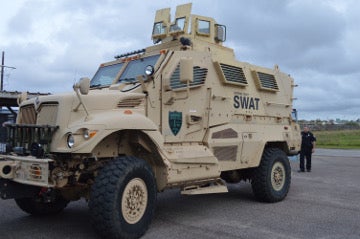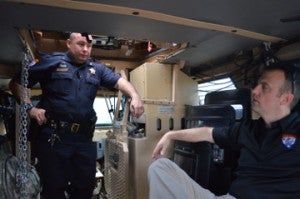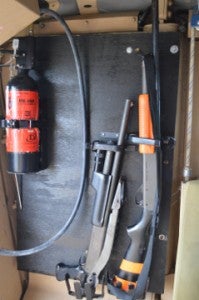Training, team work, keep SWAT prepared
Published 1:44 pm Monday, December 14, 2015

- Deputy Jerry Droddy directs another team member as he backs up the SWAT vehicle. Mary Meaux/The News
Special Weapons And Tactics team members go through intense training, putting their lives on the line to save others.
SWAT members and Jefferson County Sheriff’s deputies Marcus Mclellan and Deputy Jerry Droddy shed some light into what goes into the training.
Each member of the JSCO SWAT team carries 50 pounds of gear when responding to an incident. Their priorities are set; safety of citizens, other first responders and teammates.
“The basic SWAT school training meets the standards set for the state,” Mclellan said while seated inside the JSCO’s armored rescue vehicle. SWAT teams are members of the Texas Tactical Police Officers Association, which in turn in a member of the National tactical Offices Association. “Everybody in the state of Texas and nation gets the same fundamentals. That way we can join in any of the three local SWAT agencies and work together.”

SWAT team members Sheriff’s Deputy Jerry Droddy, left, speaks with Deputy Marcus Mclellan in the sheriff office’s armored rescue vehicle.
Mary Meaux/The News
Port Arthur and Beaumont police departments have their own SWAT teams as well as the Sheriff’s Office. The JSCO members come from the sheriff’s office, Nederland and Port Neches police department and each has their own duties with their respective departments in addition to SWAT.
“You adapt, you train such that it’s second nature. If he goes to the left, you go to the right. He trusts his life with me and I trust my life with him,” Droddy said.
Mclellan explained that trust goes with the job if they are to go home safely at the end of the day.
The training sometimes includes “simunition,” a non-lethal training ammunition where firearms shoot soap pellets for “force on force” training.
“It sting,” Droddy said of the stress inoculation drills. “When I first joined the team my heart race was high during scenarios, you think quick. Now, I’m calm.”
Mclellan said members learn to control their breathing, actions and reactions.
The team includes an administrative commander who handles legal issues and policy that needs to be followed, a tactical commander who develops the action plan for the team, negotiators and operators who perform the plan.
“We undergo mandatory 16 hours a month training and also a 40 hour week of training within the year,” SWAT member and JSCO Maj. John Shauberger said. “We train a full week as a team.”
During the weeklong training, which normally equates to way more than 40 hours, the teams go through different scenarios, shooting practice and tactics.
The JSCO armored rescue vehicle is big and tough. It holds six to eight team members not including the driver and a co-pilot who is either a tea leader or medic. The vehicle is a 2007 Maxxpro, formerly a military vehicle. The Sheriff’s Office obtained the vehicle through the 1033 Program through the National Defense Authorization Act.
The tan colored vehicle holds numerous pieces of SWAT equipment including ballistic shields, less lethal shotguns, breaching shotguns, canisters of pepper spray and more.
The SWAT vehicle, which weighs 30,000 pounds, includes a movable gun turret and is made from ballistic grade steel.
Neither Droddy or Mclellen think much about the fact they risk their lives when on SWAT duty.
“IN the moment you have your job to do,” Droddy, a third generation officer, said. “You get to the point where you don’t think about it. I tell my wife the only time to worry is if a bunch of officers show up at the house and I’m not with them.”
After a SWAT incident is concluded, the group will go through a debriefing and evaluate their actions to see what they could have done better, Mclellan said.
“There’s no such thing as perfect,” Droddy responded. “Everything is such a fluid situation and can change at a moments notice. But you still have your job to do.”
E-mail: mary.meaux@panews.com
Twitter; MaryMeauxPANews






